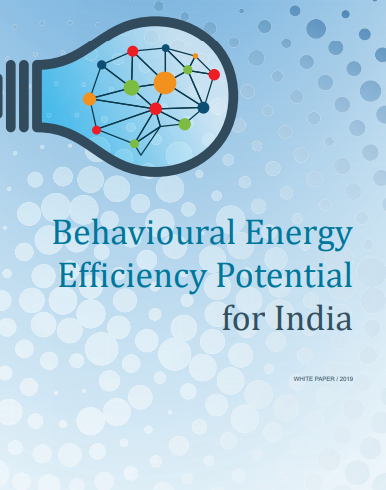Energy efficiency has an important role to play in India’s pursuit of sustainable electricity generation and consumption. Electricity demand in India has doubled in the last decade and is expected to triple by 2040. The increasing energy aspirations of the middle class, indicated by the rise in appliance ownership, and the need for space cooling are the major drivers of electricity demand. The impetus for transport electrification and the success of 100% rural electrification are contributing factors to the increasing demand. In the recent past, actions to improve energy efficiency have resulted in 15% savings in annual energy demand and a reduction of 300 million tonnes of GHG emissions (Source: IEA). Power Utility and Electric Mobility vertical is devoted to encouraging the use of energy efficiency as a resource to ensure sustainable, affordable, reliable, and modern electricity.
India’s building sector energy consumption is expected to grow by an average of 2.7% per year from 2015 to 2040, more than twice the global average. About 70% of this building sector energy demand is expected to arise come from the residential sector. Energy efficiency is an indispensable mechanism to counteract the massive amounts of investment needed for additional capacity in generation, transmission, and distribution to meet the demand. AEEE’s assessment of India’s behavioural energy efficiency potential indicates energy savings potential across India in the tune of 3400 to 10200 GWh per annum by 2030, which translates to about 1.8 to 5.3 million tonnes of yearly GHG mitigation, and customer cost savings in the range ₹ 17 to 51 billion annually.
Government of India is committed to reducing the carbon footprint of the power system, with ambitious targets for Renewable Energy. Transition to renewable energy dominated system increases the flexibility requirements in the power system for balancing energy supply and demand. The legacy grid of India dominated by coal-based thermal generation is not designed for flexible operation, and the targeted integration of 175 GW of renewable capacity has brought undue pressure on thermal generators to provide the bulk of the flexibility. Demand-side flexibility measures equally effective in effectively managing the electricity grid for reliable power supply at least cost.
Globally, the power sector is experiencing a radical change with the increasing penetration of distributed energy resources. This includes an array of resources including demand response, flexible loads, energy storage, and electric vehicles which have not received much attention in India as a flexibility resource. It is practical to incorporate flexibility resources in the distribution system, as they are the optimal solutions to as close to the loads as possible. Distributed energy resources are expected to grow significantly in India in the coming years and these resources have to provide ancillary services at the local level and bulk level if aggregated. AEEE’s Power Utility strategy is focused on advocating Demand Response as a key Distributed Energy Resource for flexibility and energy management.
High Renewables
- Shift load to period of High Renewable Energy
- Provide ancillary services to handle intermittency
Increasing Energy Demand
- Controllable loads can maintain consumer comfort and reduce system cost
Need for system modernization
- Deferring additional Transmission & Distribution Capacity
- Avoid setting up of additional power plants
Electrification
- Electric Vehicle is a grid flexibility resource
Role of Demand Side Resources in Indian Power Sector
These Distributed Flexibility Resources can alleviate many of the pain points for electricity distribution, the Achilles heel in the Indian Power Sector, which is currently facing the following critical challenge:
- Manage peak power demand, which has been increasing at a Compound Annual Growth Rate (CAGR) of over 4% and has reached 1,83 GW in 2019-20. The power demand is estimated to reach 339 GW in 2029-30. (Source: Ministry of Power, Central Electricity Authority)
- Reduce the rise in power procurement cost of utilities which constitutes about 80% of the cost of supply
- Improve the financial health of DISCOMs, which have booked a cumulative loss of ₹ 27,000 Cr. in 2018-19
- Reduce the gap between the actual cost of supply and tariff and henceforth, subsidy burden of DISCOMs
- Reduce the carbon footprint of the power system by achieving NDC targets of reducing the emissions intensity of GDP by 33% to 35% by 2030 from 2005 level, about 40% cumulative electric power installed capacity from non-fossil fuel-based energy resources by 2030 (Source: Ministry of Environment Forest and Climate Change)
At AEEE, our research team under the strategic area of Power Utility (PU) focuses on electricity distribution and demand flexibility to address the challenges of the Indian Power Sector. The team brings in a unique value proposition by undertaking in-depth research and stakeholder engagement to bridge knowledge-gaps, and by facilitating policy and regulatory reforms.
At AEEE, we believe that distributed flexible energy resources and demand-side management would:
- Promote Negawatts, i.e. avoided energy consumption
- Minimize investment for additional generation, transmission and distribution capacity
- Ensure affordable and reliable power supply
- Optimal operation of the grid and utilization of distribution assets
- Improve the offtake of renewable energy
- Manage electricity peak demand
- Make the power system resilient and less carbon-intensive

